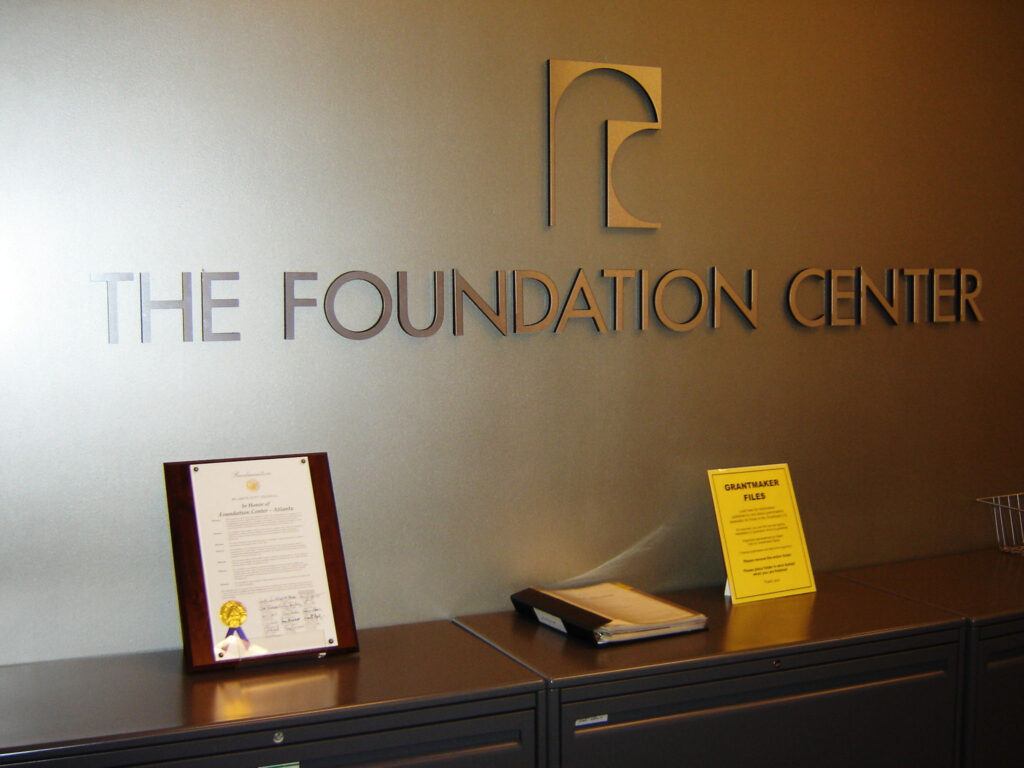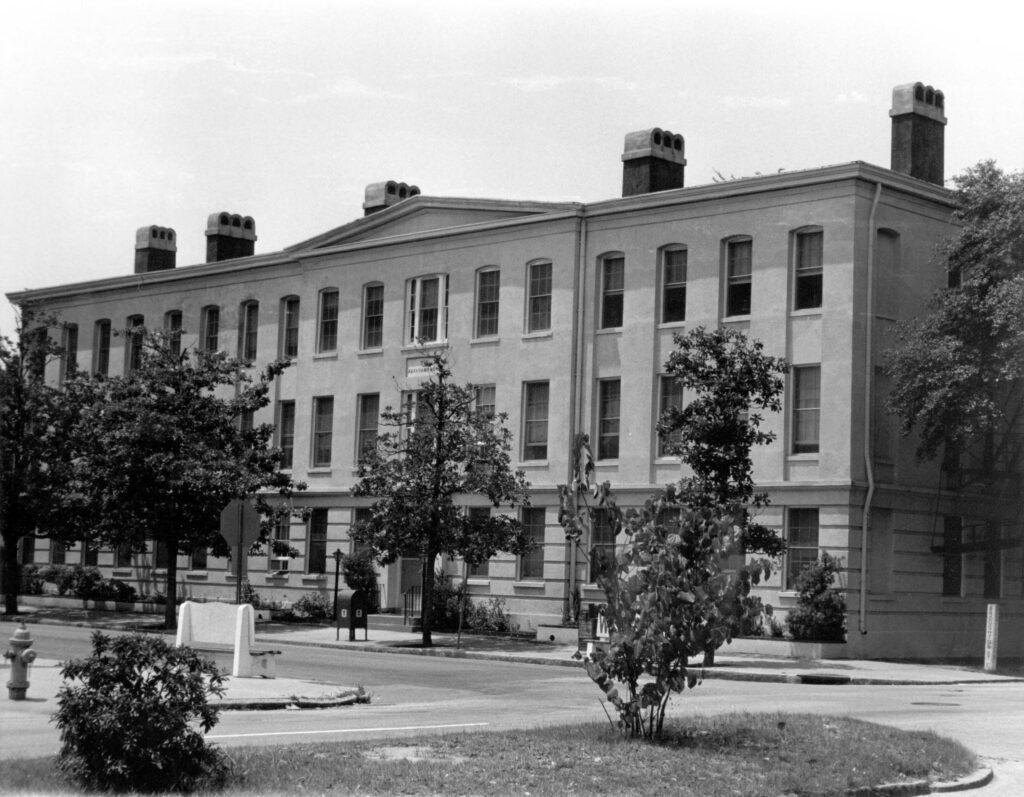In 2002 there were approximately 1,200 foundations in Georgia with combined assets in excess of $8 billion and annual giving of more than $650 million. The assets and funding interests of foundations vary widely, ranging from multibillion-dollar organizations that give to a variety of causes to small family-run organizations with limited resources and very specific giving interests. Each has a place in Georgia’s philanthropic community. Foundations are found throughout the state, but the largest concentration, 43 percent, is in the metropolitan Atlanta area.

Courtesy of Georgia Humanities.
Foundations Defined
A foundation is a nonprofit corporation or charitable trust, established under state law, with the principal purpose of making grants to unrelated organizations or institutions or to individuals for scientific, educational, cultural, religious, or other charitable purposes. This definition includes both private foundations and public foundations.
Foundations are usually thought of as grantmaking entities, while public charities are considered service providers and in most cases are grantseekers. However, there are no legal restrictions on the word foundation. Therefore, grantmakers may or may not include “foundation” in their name; organizations that do not make grants may also be called foundations.

Courtesy of UPS
The differences between private and public foundations are established by the Internal Revenue Code. Once a nonprofit organization such as a foundation has been legally established in Georgia, it must obtain recognition as a charitable organization from the Internal Revenue Service in order for contributions to it to be tax deductible.
The most prevalent characteristic of a private foundation is that its funds come from one source, such as an individual, a family, or a corporation. “Public foundation” is used to describe public charities with the primary purpose of making grants. Public foundations generally receive their assets from multiple sources, including private foundations, individuals, government agencies, and fees for service.
Private Foundations
Most early foundations in the United States were established for the benefit of a particular institution, such as a hospital or school, or to meet a specific social need, such as relief for the poor. The oldest foundation in Georgia still in existence is the Savannah Widows Society, an operating foundation established in 1822 to assist elderly or disabled women of extremely limited income in Chatham County.

Courtesy of Georgia Historical Society.
The “general-purpose” foundations, many of which still continue today, emerged in the early twentieth century. These foundations have large endowments and broad public purposes, enabling them to address major social issues. They focus their giving on a variety of issues, and their governing boards usually have the authority to change their focus as needs change, reviewing and adapting their grantmaking strategies or programs. One of Georgia’s oldest general-purpose foundations is the J. Bulow Campbell Foundation, which was established in 1940.
Today there are three major types of private foundations, each of which functions differently. All three types are represented in Georgia.
Independent foundations are the most prevalent type of private foundation in the United States and in Georgia. An individual or family usually provides the assets for the foundation in the form of gifts or bequests that are held as an endowment. The interests and giving practices of these foundations are as varied as the individuals and families that established them. The vast majority have no paid staff and no official publications.
In 2002 Georgia’s 1,132 independent foundations held assets in excess of $6.9 billion and gave away $519.7 million. Annual giving for about 5 percent of these foundations was more than $1 million; however, more than 70 percent of the independent foundations gave less than $100,000 in grants. Examples of independent foundations in Georgia include the Robert W. Woodruff Foundation, the William I. H. and Lula E. Pitts Foundation, and the Tull Charitable Foundation.
Independent foundations are sometimes called family foundations. There is no legal definition of a family foundation. The philanthropic community usually calls an independent foundation a family foundation if the donor or family members of the donor continue to have significant involvement in the running of the foundation. The Arthur M. Blank Family Foundation, the Goizueta Foundation, and the Turner Foundation are independent foundations that could also be called family foundations.

Courtesy of Kallmann McKinnell and Wood Architects, Inc.
Corporate foundations, also called company-sponsored foundations, are usually established as private foundations, receiving their assets from a company rather than an individual or family. A company-sponsored foundation and the company that established it are separate legal entities. Because the sponsoring company tends to fund most of its giving through annual contributions to the foundation, a corporate foundation’s assets are usually much smaller than its giving would indicate.
In 2002 there were fifty company-sponsored foundations in Georgia, with assets of nearly $362 million and giving of nearly $100 million. About 40 percent give in the $100,000 to $1 million range annually. Another 20 percent of the corporate foundations give between $1 million and $6 million annually. Examples of Georgia’s corporate foundations include the BellSouth Foundation (later AT&T Foundation), Coca-Cola Foundation, the Georgia Power Foundation, and the UPS Foundation.

Image from Counse
Recently, a few companies have established foundations as grantmaking public charities. Funding comes from vendors, franchisees, employees, or some other base of support. The Home Depot Foundation and the AFC Foundation are examples of Georgia corporate foundations that have been established as grantmaking public charities.
Operating foundations, a third type of independent foundation, are considered private foundations because the source of most of their assets is usually an individual or a small group of donors. They accomplish their charitable goals primarily by operating their own programs rather than by making grants. About half of operating foundations also make grants, which are usually for purposes related to the programs they operate.
In 2002 there were seventy-one operating foundations in Georgia with $544.5 million in assets. They gave $3.4 million to organizations outside the program the foundations were established to operate. Examples of operating foundations in Georgia include the Beehive Foundation; Anverse, Inc.; and the University Financing Foundation.
Public Foundations
A public foundation is a nongovernmental public charity with the primary purpose of making grants to unrelated organizations or individuals.
Community foundations, the best-known category of public foundation, usually qualify as public charities under the Internal Revenue Code because their funding is from multiple sources. Their endowments typically are composed of a number of individual funds. The community foundation’s board (or a distributions committee) oversees the grantmaking. Although grants are usually limited to nonprofit organizations within the foundation’s geographically defined area, community foundations may manage funds intended to benefit other geographic areas, including those outside the United States.
Although 661 community funds made up just 1 percent of all foundations in the United States in 2002, they accounted for more than 8 percent of the grant dollars awarded that year. Ten of those community foundations were located in Georgia and held $519.5 million in assets. Their giving in 2002 amounted to $53.7 million. Although Georgia’s largest and oldest community foundation, the Community Foundation for Greater Atlanta, received $27.6 million in gifts in 2002, most of Georgia’s community foundations give in the $1-3 million range annually. Other examples of Georgia’s community foundations include the North Georgia Community Foundation and the Community Foundation for the Central Savannah River Area.

Other public foundations include an assortment of grantmaking public charities that raise and distribute money around a particular topic or population group. Some focus on specific populations, such as women or children, and others concentrate on specific fields, such as health, arts, or social change. Their fund-raising and grant making may be local, regional, national, or international.
Of the more than 4,000 grantmaking public charities in the country, 77 are based in Georgia. Twenty of them give in excess of $1 million annually, with two (the American Cancer Society and the National Christian Charitable Foundation) making grants in excess of $100 million. Other examples of Georgia’s public foundations include the Atlanta Women’s Foundation, the Southern Education Foundation, and Georgia Humanities.
Government Oversight
In addition to witnessing the emergence of various types of foundations—general-purpose, corporate, and community—the twentieth century saw the creation of laws regulating foundations and the establishment of organizations and associations to improve practice, advocate policy, and promote public understanding.

Courtesy of Georgia Humanities.
American foundations began to attract congressional scrutiny early in the twentieth century, soon after the first ones were formed. From 1915 through the 1950s, the U.S. Congress periodically investigated private foundations, but no restrictive legislation resulted. A congressional investigation of foundations initiated in 1961 and a study of foundations by the U.S. Treasury Department in 1964 ultimately led to a whole new regulatory framework for foundations in the Tax Reform Act of 1969. This legislation created the private-foundation designation and included company-sponsored foundations in the rules governing them. The act also recognized a special status and provided a separate category for community foundations. Passage of the Tax Reform Act served as an impetus for foundation leaders in the South, including those in Georgia, to meet and establish the Southeastern Council of Foundations. This membership association of grantmaking foundations and programs is based in Atlanta and continues to provide information, education, and technical assistance to its members. The Southeastern Council of Foundations also works to create new philanthropic resources to benefit the region.
The Foundation Center was established in New York in 1956 to be a useful resource for anyone seeking information about grantmaking foundations. Advancing knowledge about U.S. philanthropy remains its primary purpose. The center’s audiences include foundations, nonprofit organizations, corporations, policymakers, the media, and the American general public. To better serve these constituencies, the center established regional library/learning centers throughout the country. In 1994 the center’s Atlanta office opened to provide resources and training to Georgia and eleven other southern states.
Development of Foundations
Foundations are located in every state, but the majority of them are concentrated in the Northeast. In 2002 foundations in New England and the mid-Atlantic states combined controlled 30.6 percent of foundation assets. The unequal distribution of foundation assets across the country is a result of economic and industrial development patterns as well as the personal preferences of the donors. However, the funding policies of large national foundations, which give substantial amounts outside the states in which they are located, mitigates to some extent this unequal distribution. More than 400 foundations located in other states have a stated interest in giving in Georgia.
Since 1975, changing demographic patterns and relatively rapid economic and industrial growth in the West and South have stimulated a higher rate of growth in the number of foundations and foundation assets in those areas. Among southern states in 2002, foundation assets grew from 17.6 percent of national foundation assets in 1975 to 21.4 percent, and grants grew from 16.9 percent of national foundation giving to 22.5 percent. Foundation growth in this area reflects the economic growth of the region. Between 1992 and 2002 the number of foundations in Georgia increased dramatically, growing from 636 in 1992 to 1,263 in 2002. The largest increase was in the formation of community foundations, which increased by 233 percent. The dramatic increase in Georgia’s foundation assets and giving can be attributed to the formation of large new foundations and an increase in corporate activity in the state, as well as important additions to the endowments of several established foundations.


















